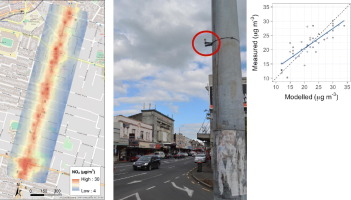Science of the Total Environment ( IF 8.2 ) Pub Date : 2017-11-13 , DOI: 10.1016/j.scitotenv.2017.11.028 L.F. Weissert , J.A. Salmond , G. Miskell , M. Alavi-Shoshtari , D.E. Williams

|
Land use regression (LUR) analysis has become a key method to explain air pollutant concentrations at unmeasured sites at city or country scales, but little is known about the applicability of LUR at microscales. We present a microscale LUR model developed for a heavy trafficked section of road in Auckland, New Zealand. We also test the within-city transferability of LUR models developed at different spatial scales (local scale and city scale). Nitrogen dioxide (NO2) was measured during summer at 40 sites and a LUR model was developed based on standard criteria. The results showed that LUR models are able to capture the microscale variability with the model explaining 66% of the variability in NO2 concentrations. Predictor variables identified at this scale were street width, distance to major road, presence of awnings and number of bus stops, with the latter three also being important determinants at the local scale. This highlights the importance of street and building configurations for individual exposure at the street level. However, within-city transferability was limited with the number of bus stops being the only significant predictor variable at all spatial scales and locations tested, indicating the strong influence of diesel emissions related to bus traffic. These findings show that air quality monitoring is necessary at a high spatial density within cities in capturing small-scale variability in NO2 concentrations at the street level and assessing individual exposure to traffic related air pollutants.
中文翻译:

微型土地利用回归模型的开发,用于预测新西兰奥克兰市人口密集郊区的NO 2浓度
土地利用回归(LUR)分析已成为解释城市或国家规模未测量地点的空气污染物浓度的关键方法,但对于LUR在微观尺度上的适用性知之甚少。我们介绍了为新西兰奥克兰的一个繁忙路段开发的微型LUR模型。我们还测试了在不同空间尺度(本地尺度和城市尺度)下开发的LUR模型在城市中的可传递性。夏季在40个地点测量了二氧化氮(NO 2),并根据标准标准建立了LUR模型。结果表明,LUR模型能够捕获微观尺度的变异性,该模型解释了NO 2中66%的变异性浓度。在此规模下确定的预测变量为街道宽度,到主要道路的距离,遮阳篷的存在和公交车站的数量,后三个变量也是当地规模的重要决定因素。这突出了街道和建筑物配置对于街道一级的个人暴露的重要性。但是,城市内部的可转移性受到限制,因为在所有测试的空间尺度和位置上,公交车站的数量是唯一重要的预测变量,这表明柴油排放对公交交通的影响很大。这些发现表明,在城市中以较高的空间密度进行空气质量监测对于捕获NO 2的小范围变化是必要的 在街道一级的浓度,并评估个人与交通相关的空气污染物的暴露。










































 京公网安备 11010802027423号
京公网安备 11010802027423号